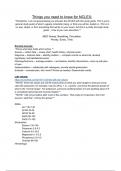Things you need to know for NCLEX:
**Disclaimer: I am not guaranteeing you will pass the NCLEX with this study guide. This is just a
general study guide of what I vaguely remember being, or think you will be, tested on. This is in
no way, shape, or form everything that will be on your exam, but this is a pretty thorough study
guide. :) Use at your own discretion.**
ABC! Airway. Breathing. Circulation.
Priority. Every. Time.
Nursing process:
**Know what step holds which action.**
Assess→ collect data→ review chart, health history, physical exam..
Diagnose→ interpret data→ identify problem → compare normal vs abnormal, develop
hypothesis, test/validate/document
Planning/Outcome→ manage problem→ set timeline, identify interventions, come up with plan
of care
Implementation→ collaborate with colleagues, provide teaching/education
evaluate plan, did it work? Revise as needed. Disseminate results.
Evaluate→
Lab values:
https://nurselinds.com/2018/11/25/lets-talk-lab-values/
**NOTE: Some lab values are not the exact same as what you were taught or what you know.
Labs like potassium, for example, may be off by .1 or .2 points. Just know the general spread of
what is the “normal range”. For potassium, just know anything below 3.0 and anything about 5.5
is considered abnormal and must be treated.**
**NOTE: I did not put letters after most of the numbers. That really isn’t important. Don’t tell
anyone I said that. :) Know the spread.**
ABGs-
pH 7.35-7.45
pCO2 35-45
HCO3 24-26
SaO2 90-100
PaO2 75-100
Electrolytes-
Sodium 135-145
Potassium 3.5-5.3
Calcium 8.5-10.9
Magnesium 1.5-2.5
Phosphorus 2.5-4.5
Chloride 98-106
Hematology-
, RBC 4.5-5.0 million
WBC 4,000-11,000
Platelets 150,000-400,000
Hemoglobin 12-18 (varies for male and female)
Hematocrit 37-52% (varies for male and female)
Therapeutic drug levels
Digoxin 0.8-2.0
Gentamicin 5-10
Lithium 0.8-1.2
Phenobarbital 10-30
Vancomycin 10-20
PT/INR
PT 10-12 seconds
INR- Not on blood thinner- <1.1
INR- Blood thinner- therapeutic at 2.0-3.0
Heparin= PTT
Coumadin= INR
PTT 30-45 seconds
Hemoglobin A1C
Normal <5.7
Prediabetic 5.7-6.4
Diabetic > 6.4
ESR (measures inflammation) 0-29 mm/hr
Glucose 80-120
Creatinine 0.6-1.5
BUN 7-22
Specific gravity 1.010-1.030
Lipid panel
LDL <130
HDL >50
Triglyceride <150
Total cholesterol 150-200
Liver Function Test (LFTs)
ALT 7-55
AST 8-48
Prostate Specific Antigen (PSA) <4.0
Lead <40
Vitamins/nutrients needed during pregnancy:
Folic acid 4000 mcg or 400 mg → decreases risk for neural tube defects
Iron
Calcium
Vitamin D
, DHA
Iodine
Know infant vitals:
Heart rate 85-190
Respiratory rate 30-60/minute
Blood pressure 72-104 systolic and 37-56 diastolic
Know adult vitals:
Heart rate 60-100
Respiratory rate 12-20/minute
Blood pressure 100-130 systolic and 60-80 diastolic
Blood types and transfusions:
The universal blood donor has Type O- blood.
The universal plasma donor has Type AB blood.
Check baseline vitals before initiating transfusion.
Stay with patient for 15 minutes once transfusion has been started.
ONLY GIVE BLOOD WITH NORMAL SALINE.
Check vitals once transfusion has been running for 15 minutes and once blood
administration is completed.
Must have dual nurse check off before starting transfusion.
Must obtain consent before starting transfusion.
Must have a working IV sized 20 or larger.
Must transfuse blood product within 4 HOURS of receiving it.
Blood transfusion reactions:
- Hemolytic→ blood types are incompatible. S/s: fever, chills, back pain, elevated heart
rate, diaphoretic, low blood pressure, and anxiety. STOP TRANSFUSION
IMMEDIATELY. Disconnect tubing from patient. Begin a normal saline infusion using
NEW tubing. Notify MD immediately. Gather all blood products-tubing, blood, etc. and
send to lab.
- Febrile→ occurs because the body has produced anti-white blood cell antibodies. S/s:
fever, chills, elevated heart rate, and low blood pressure.
- Allergic→ patient develops allergy to something in the blood their receiving. S/s:
minor→ rash, itching, hives, flushing. Major→ anaphylaxis. STOP TRANSFUSION.
Disconnect tubing from patient. Begin normal saline infusion using NEW tubing. Notify
MD. Administer benadryl if minor reaction. Administer epinephrine, oxygen, and notify
MD immediately.
- Bacterial→ contaminated blood products. S/s: wheezing, shortness of air, skin
discoloration, chest tightness, low blood pressure, and potentially shock. STOP
TRANSFUSION IMMEDIATELY. Disconnect tubing from patient. Begin a normal saline
infusion using NEW tubing. Notify MD immediately. Gather all blood products-tubing,
blood, etc. and send to lab.
- Fluid overload→ transfusion rate is too fast. S/s: crackles, shortness of air, jugular vein
distention, coughing, and increased heart rate. Monitor closely for advancement to




